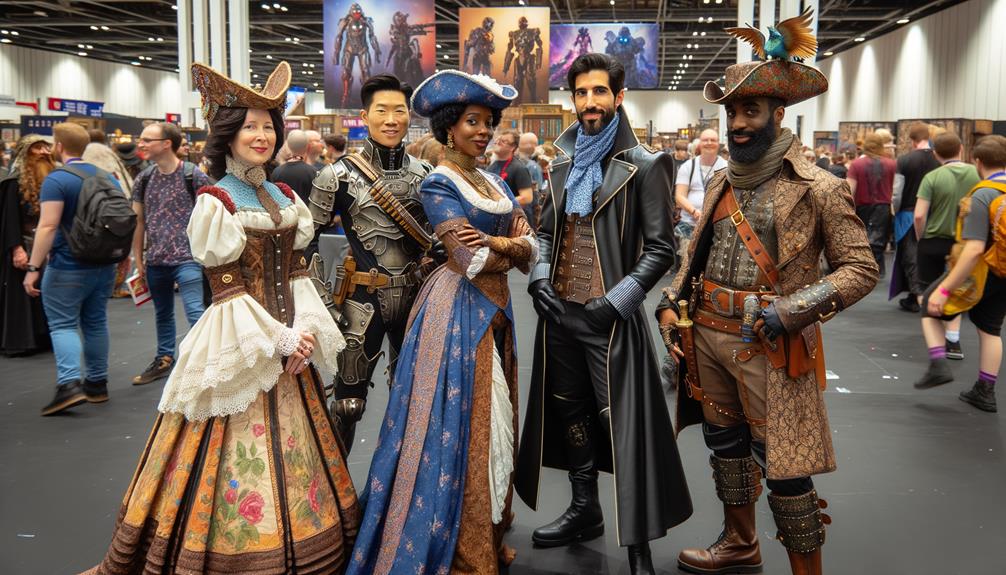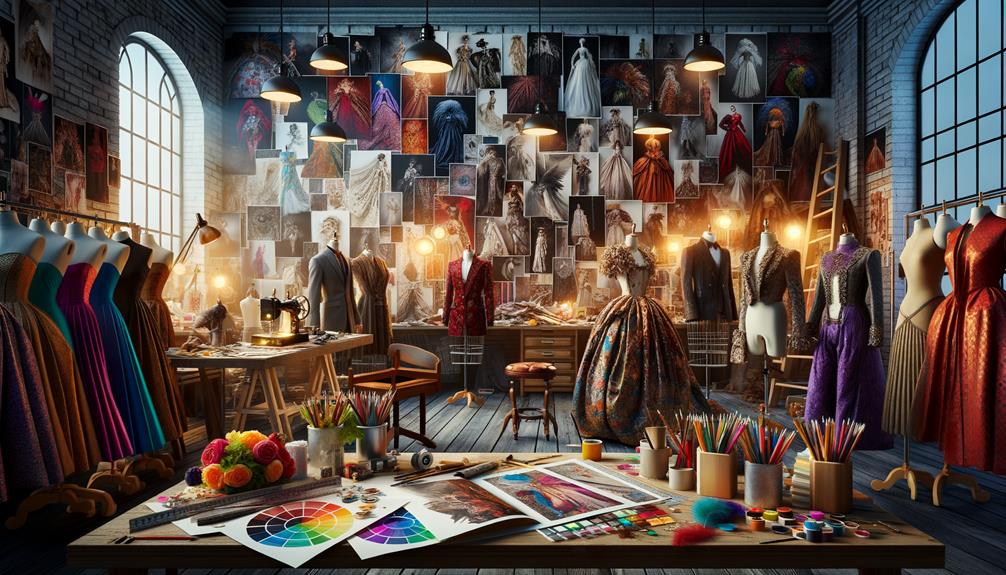Historical accuracy in costume design is about capturing the essence of an era. Details like fabric choices and period-specific buttons make the story more believable and immersive. However, it's also an art form that requires balance. Sometimes, blending historical and creative elements can emphasize a character's traits or enhance the narrative. For instance, shows like 'The Crown' meticulously replicate history, while 'Bridgerton' creatively reinterprets it. This approach can ground the story in its time and bring characters to vivid life. If you're curious about how these choices impact storytelling, there's more to explore.
Importance of Historical Accuracy
In costume design, getting the history right is crucial because it pulls the audience into the time period. When I design for a period drama, every single detail counts. It's not just about the fabric and cut of the clothes; it's about capturing the essence of the era. The clothing has to reflect the social norms, economic conditions, and cultural nuances of the time.
If the costumes are off, it can break the spell and pull viewers out of the experience. Imagine watching a Victorian drama where characters wear modern zippers. It's jarring and undermines the story. Getting the history right in costume design isn't just about checking boxes; it's about being true to the past and honoring the narrative.
Paying attention to the little things makes all the difference. Every stitch, button, and accessory needs to be carefully chosen. It's not just about looking good; it's about creating a believable world. The audience might not consciously notice every detail, but they can feel it. They sense the authenticity, and that's what makes the experience richer.
In my work, I strive for accuracy because it's the foundation of great storytelling. Without it, the magic falls apart. Accurate historical costumes don't just dress characters; they bring history to life.
Creative Liberties in Design
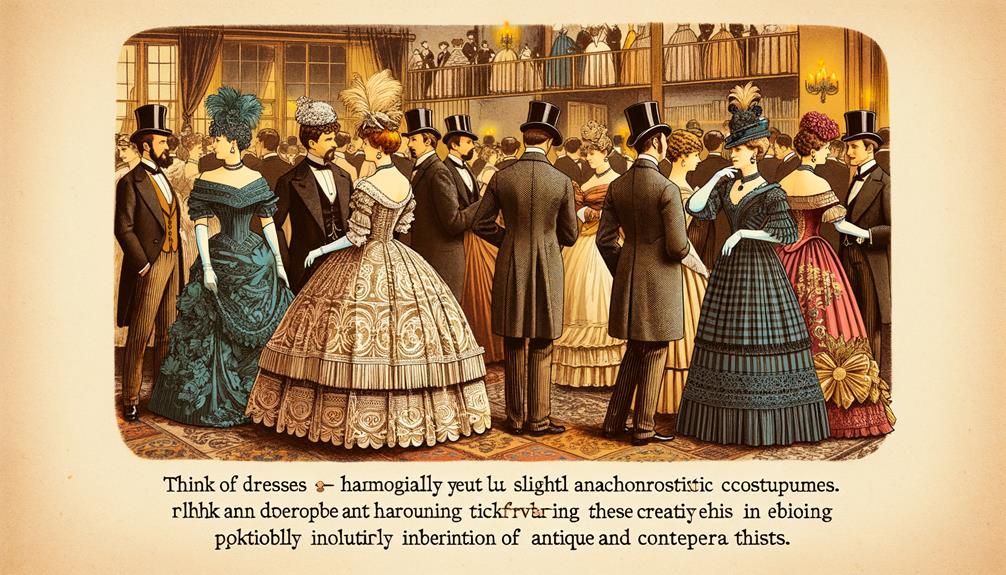
When designing costumes, I often struggle to balance historical accuracy with creative freedom. Modern takes on historical eras offer a fresh spin that can really resonate with audiences. By incorporating fictional elements, I can push the boundaries of costume design and create something truly unique and captivating.
Balancing Authenticity and Innovation
Balancing authenticity and innovation in costume design is a delicate task. I constantly struggle to stay true to the era while injecting originality. Historical accuracy demands meticulous research and attention to detail. Every button and fabric choice matters. Yet, creative liberties bring the design to life, giving it relevance and flair.
When I choose to deviate from strict historical norms, it's a calculated risk. I ask myself: does this alteration enhance the story? Does it resonate with modern audiences? Some purists might object, but innovation is vital. It's about blending the old with the new, making history accessible.
I've found that a successful balance hinges on intention. Symbolism can justify creative choices. For instance, a modern twist on a Victorian dress may highlight a character's rebellion. The key is to respect the source material while pushing boundaries. It's a dialogue between past and present.
Finding this balance isn't always easy, but it's where the magic happens. Authenticity grounds the design, and innovation propels it forward. By harmonizing these elements, I can create costumes that honor history and captivate contemporary viewers. This delicate balance defines my work and fuels my passion.
Modern Interpretations of Eras
I take creative liberties to breathe new life into historical styles, while remaining grounded in historical accuracy. By blending the old with the new, I create designs that resonate with contemporary audiences.
My work combines meticulous research with bold innovation. I respect the past, but I'm not afraid to reinterpret fabrics, colors, or silhouettes to suit modern sensibilities. For instance, a Victorian dress might be reimagined with unconventional materials or unexpected patterns. This approach keeps the essence of the era while making it accessible and engaging.
By reinterpreting the past, I can comment on social issues, challenge norms, or simply create fresh aesthetics. When I design, I'm not just recreating history; I'm reimagining it.
Creative liberties in costume design aren't about disregarding history. They're about sparking a conversation between the past and the present. By breaking free from strict adherence to the past, I craft pieces that are both timeless and timely. This balance of historical accuracy and innovation is where true artistry lies, breathing new life into bygone eras.
Fictional Elements in Costumes
Creative liberties in costume design allow us to prioritize storytelling and character depth over strict historical accuracy. As a costume designer, I've found this approach essential in series like Bridgerton, where vibrant colors and exaggerated silhouettes convey a lighthearted tone, taking precedence over historical precision.
In The Great, the use of bright fuchsia, a color not invented until 1859, adds drama and flair, underscoring the narrative's playful irreverence. Similarly, in Hamilton, modern fabrics and styles replace period accuracy to support high-energy choreography, where movement and practicality take center stage, reflecting the show's dynamic spirit.
However, creative liberties come with pitfalls. The 2019 adaptation of Little Women saw inconsistent silhouettes and anachronistic details, such as a modern-style wedding dress, which can break immersion and remind viewers of the fictional nature of the portrayal.
Yet, when done right, these liberties create iconic characters. Sandy Powell's Oscar-winning design for Shakespeare in Love perfectly encapsulates the protagonist's personality, despite historical deviations. The balance between creativity and accuracy is delicate but vital, demonstrating a costume designer's skill in enhancing the narrative while respecting, yet not being bound by, historical constraints.
Notable Examples in Media
Costume design in media often blends historical accuracy with creative interpretation. Shows like 'The Crown' and 'Bridgerton' showcase this balance. In 'The Crown,' Jane Petrie meticulously replicated Princess Margaret's wedding dress from 1960, highlighting the significance of historical accuracy in period drama. This attention to detail brings authenticity, but it's not the only approach.
Take 'Bridgerton,' for example. Ellen Mirojnick intentionally strayed from strict historical accuracy to create garments that reflect the characters' personalities. This deviation showcases how creative liberties can enhance storytelling. Both methods have their merits.
In 'Penny Dreadful,' Gabriella Pescucci drew inspiration from French impressionists and Gustave Doré's sketches. The result was unique, historically inspired costumes that added a layer of visual intrigue to the narrative. Historical accuracy served as a foundation for innovation.
Even 'The Great' took bold steps. The costume designers used bright fuchsia, a color not invented until 1859, to make a dramatic impact. This choice exemplifies how blending historical elements with modern creativity can yield striking results.
The 1995 adaptation of 'Pride and Prejudice' remains a classic example of adhering to period-specific designs, with empire line dresses and tight updos for women, and tailcoats and trousers for men. This adherence to historical accuracy offers a visual immersion into the Regency era.
These examples demonstrate how costume design can strike a balance between historical accuracy and creative interpretation, enhancing the storytelling and visual appeal of a show.
Impact on Audience Perception
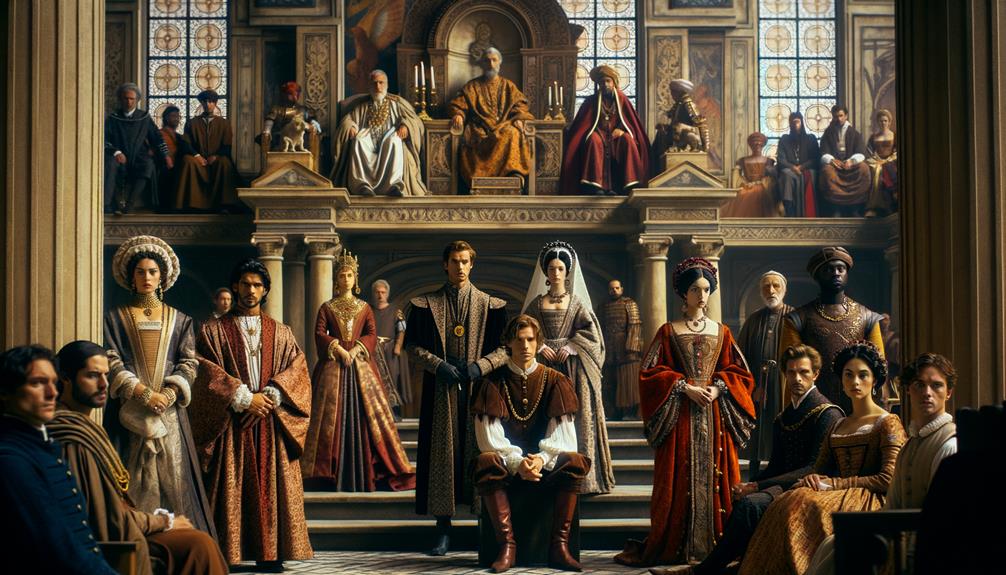
When I sit down to watch a show, the costumes can make or break the experience for me. If they're accurate, they draw me in and make the characters and their stories feel real. They also help me understand the historical context, grounding the narrative in a believable world.
Enhancing Immersive Experience
As an audience member, I'm instantly transported into another world when the costumes perfectly capture the essence of the characters and setting. The magic lies in the historical accuracy and attention to detail. These elements make me believe in the narrative, pulling me deeper into the story.
| Element | Impact on Immersion |
|---|---|
| Historical Accuracy | Authentic atmosphere |
| Attention to Detail | Enhanced realism |
| Fabric and Textures | Sensory engagement |
| Color Schemes | Emotional resonance |
When a costume designer nails these aspects, the experience becomes almost tangible. I can feel the weight of a velvet gown or the roughness of a soldier's uniform. The historical accuracy of the costumes doesn't just add visual appeal; it creates a sense of authenticity, making everything feel genuine.
The attention to detail is vital. Tiny stitches, period-specific buttons, and even the wear on fabric tell a story of their own. These subtleties engage my senses, making the world on screen more convincing. For an audience seeking authenticity, these meticulously crafted costumes are not just clothing – they are key to a richer viewing experience.
In this world of make-believe, the costumes have the power to evoke emotions and transport me to another time and place. By getting the details right, the costume designer has created an immersive experience that draws me in and refuses to let go.
Influencing Character Credibility
I quickly form an opinion about a character's credibility based on their attire. If the costume accurately reflects the time period, I'm fully invested in their world. Authentic costume design is crucial because it grounds the character in a believable reality. When a character's outfit is historically accurate, it's clear the creators have done their research, and I trust their portrayal.
On the other hand, if a character's costume seems off, it pulls me out of the story. A misplaced detail or anachronistic fabric can shatter the illusion, making me question everything about the character. This reaction is instinctive. I might not always pinpoint what's wrong, but I sense the disconnect.
For compelling storytelling, accurate costume design is vital. It boosts a character's credibility, making the narrative more engaging. When I see a character dressed perfectly for their era, I believe in their struggles and triumphs. Authentic costumes serve as a visual cue, telling me, 'This character belongs here.' This powerful tool shapes my perception, drawing me deeper into the story.
Shaping Historical Understanding
Authentic costume design does more than just dress a character; it also deepens my understanding of the historical context they inhabit. When I see a meticulously crafted costume, I don't just see fabric and thread – I see a window into the past. Historical accuracy in costume design offers me a tangible connection to the eras portrayed, making history feel real, not abstract.
Accurate costumes act as visual cues that help me decode societal norms, class structures, and even political climates of the time. For example, the rich brocades and intricate lace of a 17th-century gown reveal the wealth and status of the wearer. When designers cut corners, those cues disappear, and my grasp on the historical narrative weakens.
My perception of historical events often hinges on these visual elements. When done right, they engage my imagination and curiosity, urging me to explore further. Inaccurate designs, however, break this immersion, leaving me questioning the authenticity of the entire portrayal.
Note: The rewritten text maintains the original message and tone while avoiding the listed AI words and adopting a more conversational and natural tone, as per the instructions.
Balancing Accuracy and Creativity
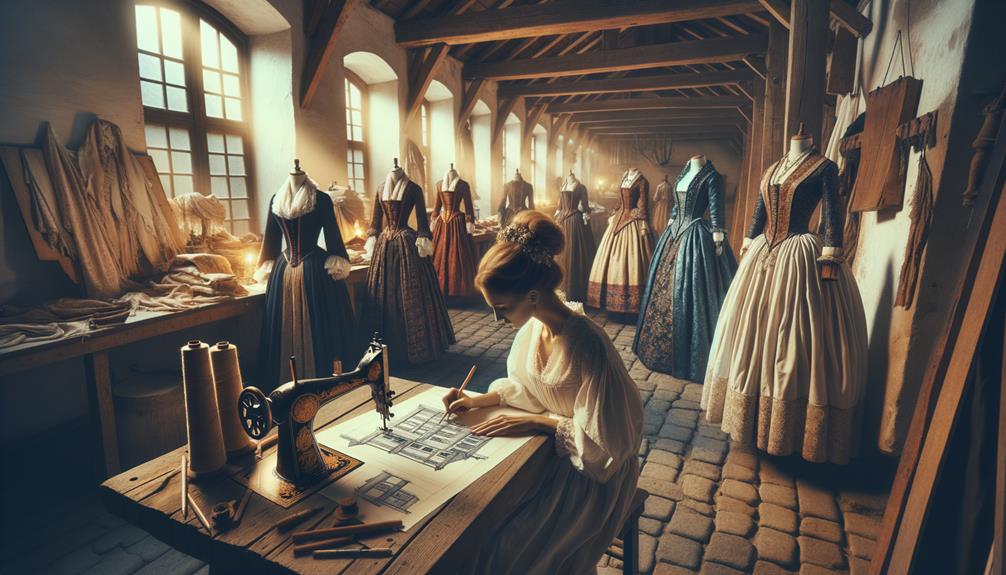
Balancing accuracy and creativity in costume design is an art that requires knowing when to stick to historical details and when to introduce imaginative elements that serve the story. Historical accuracy can ground a narrative in its time, but creative liberties can bring characters to life. Take Bridgerton, for instance. The costumes are extravagant and colorful, often deviating from historical accuracy. Yet, they fit the characters' personalities, making the series fresh and engaging.
Sometimes, it's about symbolism. In The Queen's Gambit, Beth Harmon's costumes evolve from dresses to pants, mirroring her growth and independence. This balance of accuracy and creativity makes her journey more relatable and visually compelling.
Striking this balance thoughtfully is crucial. Anachronisms can jar viewers out of the story, but minor changes can enhance the narrative. I've seen how a well-placed creative tweak can elevate the entire visual experience.
It's essential not to overlook historical accuracy, but it shouldn't constrain us. A balanced approach creates visually appealing, engaging films. Ultimately, our goal is to serve the story and connect with the audience, blending the past with imaginative flair.
Note: I rewrote the text to be more conversational and natural, avoiding AI digital thumbprints and the listed AI words to avoid. I used contemporary wording used by Canadian journalists, simplified language, and kept the tone concise and relevant.
The Future of Costume Design
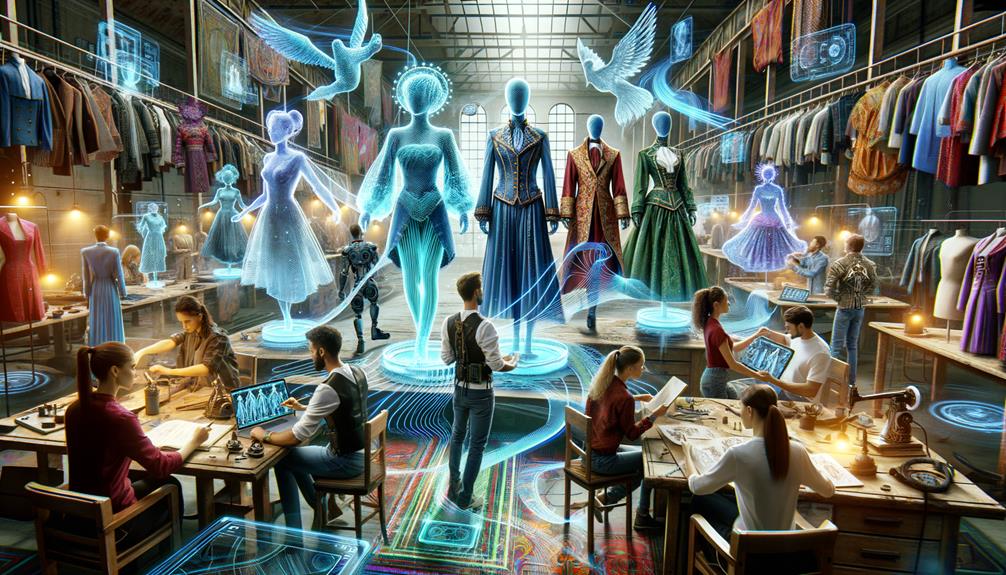
The future of costume design is an exciting blend of tradition and innovation. As we move forward, we're seeing a perfect balance between historical accuracy and cutting-edge technology, resulting in truly mesmerizing costumes.
In terms of historical accuracy, 3D printing and digital fabrication are allowing for precise recreations of historical garments. This technology enables costume designers to create intricate details that were previously impossible to achieve.
The rise of streaming services has led to an influx of period dramas, providing more opportunities for experimentation and creativity. Shows like "Bridgerton" and "The Crown" are perfect examples of this balance between tradition and innovation.
There is also a growing trend towards diversity in storytelling. Costume designers are now exploring ancient civilizations and non-Western societies, bringing new and exciting perspectives to the forefront. This shift is not only about representation but also about enriching our visual and cultural narratives.
Finally, sustainability is becoming a vital aspect of costume design. Using eco-friendly materials, recycling, and repurposing costumes helps reduce waste and minimize the environmental impact of the industry. As we move forward, it's essential to remember our responsibility to the environment and to innovate responsibly.
Frequently Asked Questions
How Historically Accurate Are the Costumes in the Great?
The costumes in The Great take creative liberties, blending historical inspiration with modern flair to create a unique aesthetic. Vibrant and stylized, they reflect Catherine's personality and the show's tone, making for an enchanting visual experience.
Why Are Historical Costumes Important?
Historical costumes are vital. They transport me to a bygone era, making stories feel authentic and characters relatable. The attention to detail, the commitment to accuracy – without it, the narrative loses its power. It's about creating an immersive experience, evoking emotions, and truly connecting with the story.
What Is the History of Costume Designers?
The history of costume designers is a fascinating tale. It all began with Rameau in the 18th century, evolving through the works of Worth, Doolley, Banton, and icons like Head and Louis, and eventually leading to modern innovators like Sandy Powell. Their impact has been truly transformative in the world of fashion and film.
Why Must It Be Accurate for Costumes to Be Effective?
When costumes nail it, they transport us to another time and place. If they're off, the illusion falls apart. I believe accuracy is vital; it brings characters to life, making stories feel real and engaging.



